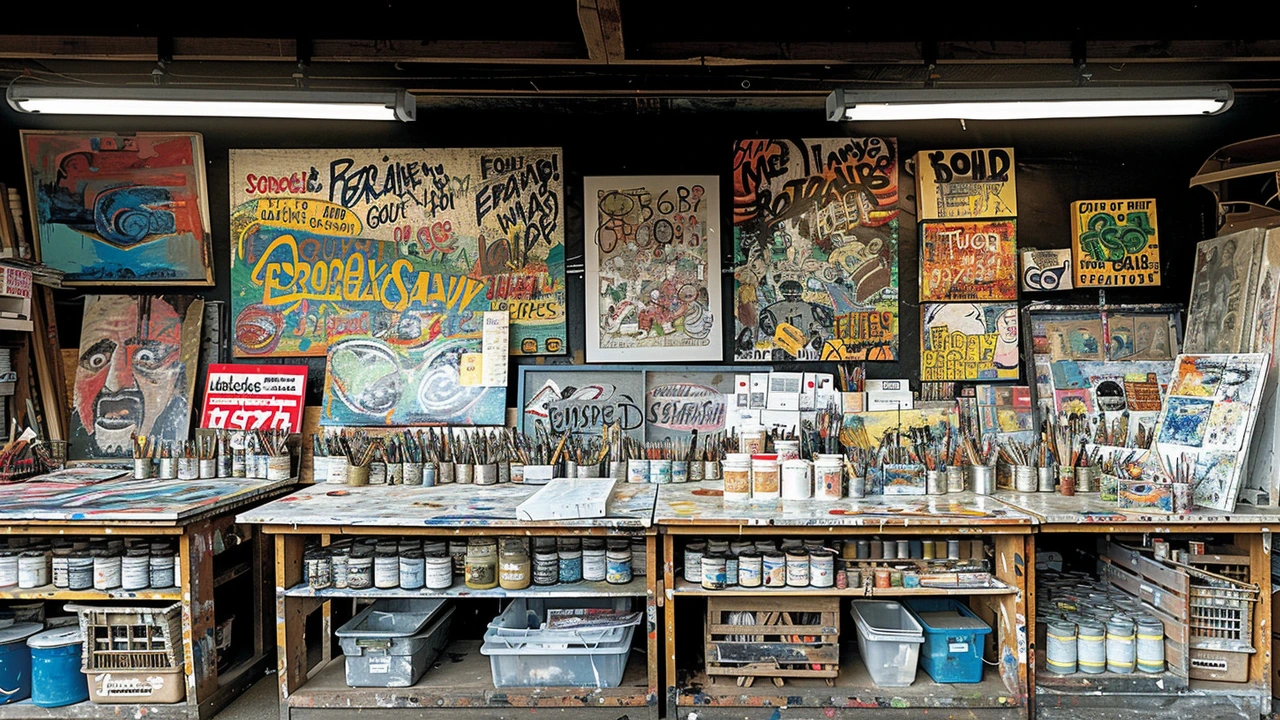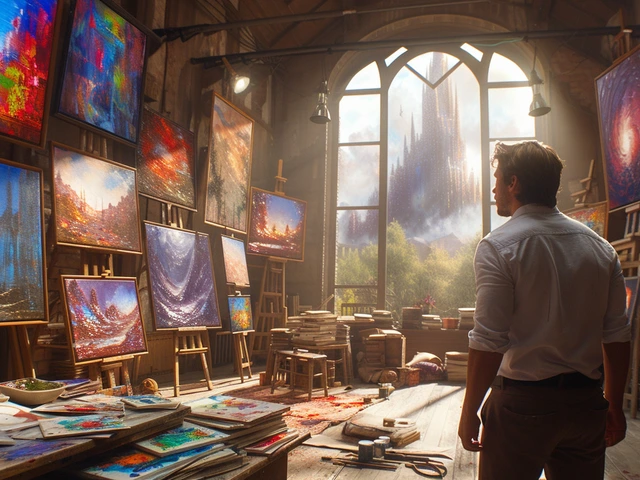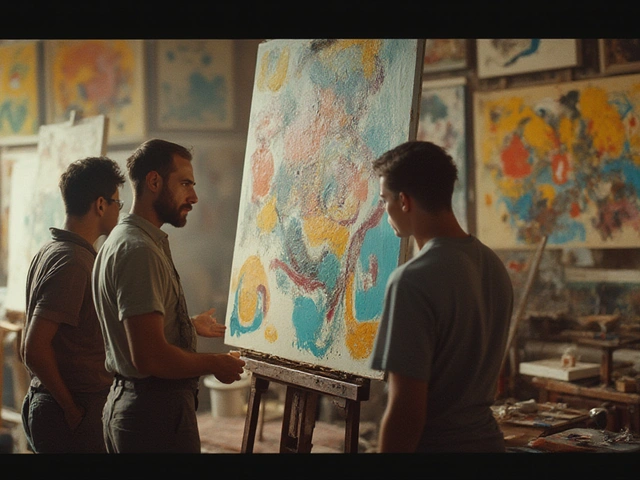Fluxus was more than an art movement; it was a radical shift in how artists approached creativity and expression. Emerging in the early 1960s, it brought together diverse disciplines, from visual arts to music and performance, under one roof.
Fluxus artists sought to break down the barriers between art and life, believing that creativity should be free from the confines of traditional forms and institutions. This approach not only defied conformity but also encouraged experimentation and collaboration.
In this article, we'll delve into the origins of Fluxus, meet its key figures, and explore its defining characteristics. We'll also look at some of the most significant works and performances from the movement and consider the lasting impact Fluxus has had on the art world.
Join in and discover how Fluxus continues to inspire artists today, pushing the boundaries of what art can be.
- The Birth of Fluxus
- Key Figures of the Movement
- Characteristics of Fluxus Art
- Significant Works and Performances
- Impact and Legacy
- Fluxus in Modern Art
The Birth of Fluxus
The Fluxus movement began in the early 1960s, a time when the art world was ripe for change. Rooted in the desire to break down the boundaries between art and life, Fluxus challenged traditional artistic norms. The name ‘Fluxus’ itself is derived from the Latin word meaning ‘flow’ or ‘change,’ which perfectly encapsulated the movement’s fluid and dynamic nature.
It all started with George Maciunas, a Lithuanian-American artist. He was the key figure behind the movement, organizing and fostering a community of like-minded artists. Maciunas hosted the first official Fluxus event in 1961 in Wiesbaden, Germany. The festival, known as the ‘Fluxus Internationale Festspiele Neuester Musik,’ featured a series of unconventional performances and artworks that immediately captured the attention of the avant-garde art scene.
One of Maciunas' goals was to demystify art. He believed art should be accessible and integrated into everyday life. This was a rebellious stance against the elitist art establishments of the time. Fluxus artists created works that were often humorous, absurd, and deliberately low-tech. They sought to engage everyone, not just a privileged few, in the creative process.
A crucial moment in the birth of Fluxus was Maciunas’ publication of the ‘Fluxus Manifesto’ in 1963. In this document, he outlined the movement’s core principles: simplicity, fun, and aesthetics in everyday life. He urged artists to produce «anti-art,» rejecting the elitism and commercialism of mainstream culture. Maciunas’ vision was to revolutionize art by making it a part of the daily experience, breaking away from the confines of galleries and museums.
The movement quickly spread across Europe and the United States, attracting a diverse group of artists from various disciplines. Notable among them were Yoko Ono, Nam June Paik, and John Cage. Their collaborative and interdisciplinary approach became a hallmark of the movement.
As Maciunas famously said, “Promote a revolutionary flood and tide in art, promote living art, anti-art.”
The early Fluxus events were often chaotic and unpredictable, emphasizing spontaneity and audience participation. This was a sharp departure from the traditional, spectator-only model of art engagement. These performances often blurred the line between the artist and the audience, inviting viewers to become an integral part of the artwork itself.
In essence, the birth of Fluxus represented a radical shift. It embraced a democratic, inclusive approach to art, one that celebrated the mundane and the everyday as much as the extraordinary. Fluxus laid the groundwork for future movements that would continue to push the boundaries of what art could be.
Key Figures of the Movement
Fluxus was a collective effort brought to life by an eclectic group of artists who dared to challenge the traditional boundaries of art. One of the most notable figures was George Maciunas, often regarded as the movement's principal organizer. Maciunas, a Lithuanian-born artist, graphic designer, and architect, was instrumental in shaping Fluxus. He envisioned it as an anti-art movement that could seamlessly merge art with everyday life. Maciunas even designed the Fluxus Manifesto, echoing his vision of breaking down the distinctions between art and the ordinary.
“Purge the world of bourgeois sickness, ‘intellectual,’ professional & commercialized culture…” — George Maciunas, Fluxus Manifesto
Another pioneering influence in Fluxus was Yoko Ono, who is widely recognized not just for her artistic contributions but also for her position within popular culture. Ono’s conceptual performances, like her 'Cut Piece' in 1964, drew audiences into the participatory essence of Fluxus. Her work challenged the passive consumption of art, making spectators active participants in the creation process.
Nam June Paik, a Korean-American artist, became a leading figure in Fluxus through his work with video art. Often considered the 'father of video art,' Paik's innovative use of television and visual media pushed the boundaries of traditional art forms and opened new avenues for multimedia art. His works, such as 'TV Cello' and 'TV Buddha,' exemplify the spirit of Fluxus by blending high-tech visuals with everyday objects.
Furthermore, we can’t overlook the influence of Dick Higgins, who coined the term 'intermedia' to describe the overlapping genres within Fluxus. Higgins's works often combined literature, music, and visual arts to create multisensory experiences. His key works include his series of influential 'Danger Music' compositions, which pushed the boundaries of what music could be.
Other notable figures include Alison Knowles, known for her 'Event Scores' that prompted everyday actions to be considered art, and Ben Patterson, whose works often incorporated sound and performance elements. Each contributed uniquely to Fluxus, reinforcing the movement’s ethos of blending art forms.
In essence, the collaboration of these key figures breathed life into Fluxus, making it a dynamic and continually evolving movement. Their contributions were instrumental in expanding the horizons of what art could be, ensuring that Fluxus remains a significant chapter in the history of avant-garde art.
Characteristics of Fluxus Art
The Fluxus movement wasn’t just about creating art; it was about revolutionizing the approach to art itself. One of the most defining characteristics was its interdisciplinary nature. Fluxus artists embraced multiple forms of media and often collaborated across various fields, including visual arts, performance, music, and literature. This eclectic approach allowed them to create works that were richly layered and multifaceted, often challenging the traditional boundaries of what art could be.
Another key aspect was the emphasis on process over product. Fluxus artists believed that the act of creation was more important than the final outcome. This philosophy led to artworks that were often ephemeral, meant to be experienced in the moment. Events known as "Happenings" were a prime example of this. These impromptu performances involved the audience as active participants, blurring the lines between artist and viewer. They were unpredictable, spontaneous, and often irreproducible, aligning perfectly with the Fluxus ethos.
A sense of humor and absurdity also permeated Fluxus art. Artists used parody, irony, and satire to challenge societal norms and question the established art world. This playful approach made their work more accessible and engaging. An iconic example is George Maciunas's Fluxkits, which were small boxes containing various objects and instructions that invited the audience to interact with the contents creatively.
Minimalism and simplicity were also integral characteristics. Fluxus works often consisted of everyday objects and found materials, emphasizing that art could be created from the mundane. This not only democratized the concept of art but also questioned the elitism often associated with fine art. As Maciunas himself famously said, "Anything can substitute art, and anyone can do it."
Interactivity and participation were encouraged. Fluxus artists sought to dismantle the passive consumption of art. They wanted audiences to engage, interpret, and even alter the artwork. This participatory nature was revolutionary at the time and paved the way for future interactive art movements.
Instruction-based art was another hallmark. Artists like Yoko Ono created works made up of specific instructions for the audience to follow, turning the concept of art into a shared experience. Ono's "Grapefruit", for example, is a book filled with art instructions that invite readers to engage in simple yet profound activities that blur the lines between daily life and artistic expression.
"Fluxus is actually the 'event' according to Dada, and we are always looking for new forms in art and life. Often, they are indistinguishable." - Dick Higgins
The use of unconventional techniques and materials was also common. Fluxus artists often rejected traditional art supplies in favor of more unexpected mediums. This inventive use of materials extended to their methods as well, with artists experimenting with new ways of combining elements to generate unique experiences.
Lastly, Fluxus showed a strong anti-commercial stance. The movement opposed the commodification of art and often created works that were difficult, if not impossible, to sell. This ideological stance was a critique of the art market and its influence on creativity, emphasizing the notion that art should remain a free, uninhibited expression.
Significant Works and Performances
Fluxus is known for its groundbreaking works and performances that often blended humor, chance, and innovation. One of the hallmark events was the first Fluxus Festival in Wiesbaden, Germany, in 1962. Organized by George Maciunas, the event collected various young artists aiming to redefine the art landscape.
Among the most iconic performances, **Yoko Ono's** "Cut Piece" stands out. In this performance, Ono sat on stage with a pair of scissors and invited audience members to come up and cut pieces of her clothes. This work compellingly addressed themes of trust, vulnerability, and social interaction. Another notable piece is **Nam June Paik's** "Zen for Head", where Paik dipped his head into a bowl of ink and dragged it across a scroll of paper. This act was a commentary on the physicality and immediacy of creating art.
**George Brecht** was another central figure, particularly known for his "Event Scores" – simple instructions written on cards to be performed as mundane actions, which transformed everyday acts into art. One famous score, called "Drip Music", instructed the performer to let water drip into various vessels. These events imbued everyday occurrences with a sense of mystery and significance.
"Fluxus is what you make it," George Maciunas once wrote, encapsulating the essence of the movement. It was about the liberation of creative thought outside traditional norms.
**Alison Knowles** broke conventions with her "Make a Salad" performance, where she prepared a large salad during a concert and shared it with the audience. Such works blurred the line between art and life, involving the audience as an integral part of the artwork. **Dick Higgins'** contributions, like “Danger Music,” included instructions that led participants into potentially hazardous situations, questioning the limits of artistic experience.
These performances redefined art as open-ended and participatory. They emphasized the role of chance and the unpredictable nature of live events. Their influence is seen in later movements like performance art and installation art, reflecting the enduring impact of Fluxus on contemporary practices.
Impact and Legacy
Fluxus left a lasting imprint on the art world, challenging conventional art forms and changing how people perceive art. Its influence is still noticeable today as many contemporary artists draw inspiration from its emphasis on process, playfulness, and the integration of various media. Fluxus expanded the boundaries of art, breaking away from the traditional gallery space and encouraging artists to experiment with new ideas.
One of the significant impacts of Fluxus is the way it democratized art. By focusing on ordinary objects and actions, Fluxus artists asserted that art could be created by anyone and existed everywhere. This approach challenged the elitism of the art world, making art more accessible. Fluxus also embraced humor and irreverence, setting it apart from more serious art movements. This attitude influenced later movements like punk and DIY culture.
The impact of Fluxus can also be seen in its promotion of interdisciplinary collaborations. The movement brought together artists, musicians, writers, and performers, who combined their talents to create multi-sensory experiences. This interdisciplinary approach paved the way for future cross-genre projects in the arts. Many Fluxus artists also emphasized performance, pushing the concept of 'art' beyond static objects and into the realm of live action.
The legacy of Fluxus is perhaps best encapsulated by its founder, George Maciunas. His idea that art should be integrated into everyday life and accessible to all has persisted over the decades. Maciunas was quoted as saying, "Fluxus is the fusion of Spike Jones, gags, games, Vaudeville, Cage, and Duchamp." This blending of high and low culture continues to resonate with artists and audiences alike.
As Nam June Paik, a pioneering member of Fluxus, famously said, "My experimental spirit is always with Fluxus." His words echo the enduring influence of the movement and its spirit of relentless innovation.
In present times, museums and galleries often exhibit Fluxus works, and there is a growing interest in the movement’s philosophy. Institutions like the Museum of Modern Art (MoMA) have dedicated exhibitions to Fluxus, highlighting its importance and continuous relevance. These exhibits not only honor the original contributions of Fluxus artists but also shine a light on their enduring influence on modern and contemporary art.
Moreover, the digital age has revived Fluxus ideas. Artistic communities online often reflect the movement's ethos by fostering global collaboration, open-source creativity, and challenging traditional art forms. These digital platforms echo the communal and boundary-breaking nature of Fluxus.
In essence, the impact and legacy of Fluxus are profound and multi-faceted. It democratized and expanded the concept of art, leaving a mark that continues to inspire innovation and creativity. By challenging the status quo and embracing the unconventional, Fluxus has left an indelible legacy on the tapestry of art history.
Fluxus in Modern Art
Fluxus has left an indelible mark on modern art, continuing to influence contemporary artists and their approaches to creativity. The movement's legacy is evident in the way it has encouraged a breakdown of traditional art forms, fostering interdisciplinary practices that blur the lines between different artistic mediums. Today, many artists embrace the Fluxus ethos of playfulness and spontaneity, which has become a cornerstone of contemporary art.
One prominent example of Fluxus' influence can be seen in the work of contemporary performance artists who incorporate elements of music, theater, and visual art into their pieces. These artists often create immersive experiences that engage audiences in new and unpredictable ways, much like the original Fluxus happenings of the 1960s. By pushing the boundaries of what art can be, they carry on the spirit of Fluxus, challenging the definitions and norms of the art world.
In addition to performance art, Fluxus has also impacted digital and new media artists. The movement's emphasis on interactivity and participation is echoed in many modern digital art installations, where viewers are not merely passive observers but active participants. These installations often include elements that invite the audience to touch, manipulate, or even become part of the artwork itself, creating a dynamic and evolving experience.
"Fluxus did not only seek to reject tradition; it sought to transform everyday actions into art," notes art historian Hannah Higgins. "This approach has profoundly impacted modern art, making the mundane extraordinary."
The DIY (do-it-yourself) culture that emerged from Fluxus has also found a strong echo in the maker and hacker movements that are popular today. Contemporary artists who work with electronics, programming, and other technologies often share the Fluxus philosophy of using available resources creatively and subverting conventional uses of materials. This spirit of innovation and resourcefulness is a direct descendant of the Fluxus movement's experimental nature.
The collaborative aspect of Fluxus has continued to inspire modern art collectives and community projects. Artists today often work together in groups, blending their individual talents to create something that is greater than the sum of its parts. These collaborative projects are in line with the Fluxus ideals of shared creativity and breaking down the barriers between artist and audience. By working together, these artists create diverse and rich works that reflect a multitude of perspectives and ideas.
Moreover, art institutions and museums have embraced the Fluxus spirit by curating exhibitions that highlight interactive and participatory art. These exhibitions encourage visitors to engage with the works on display, fostering a deeper connection between the art and its audience. In doing so, these institutions are not only preserving the legacy of Fluxus but also ensuring that its innovative approach to art remains relevant in the 21st century.
Fluxus has also influenced the educational realm, with art schools incorporating its principles into their curricula. Students are taught to think outside traditional boundaries, experiment with materials, and collaborate across disciplines. This approach to art education prepares the next generation of artists to embrace the Fluxus ideals of innovation, participation, and boundary-pushing creativity.
In essence, Fluxus lives on in modern art by continuing to challenge and redefine what art can be. Its influence can be seen in the way contemporary artists approach their practice, embracing experimentation, collaboration, and participation. By carrying forward the principles of Fluxus, these artists ensure that the movement's legacy remains vibrant and integral to the evolving landscape of modern art.




